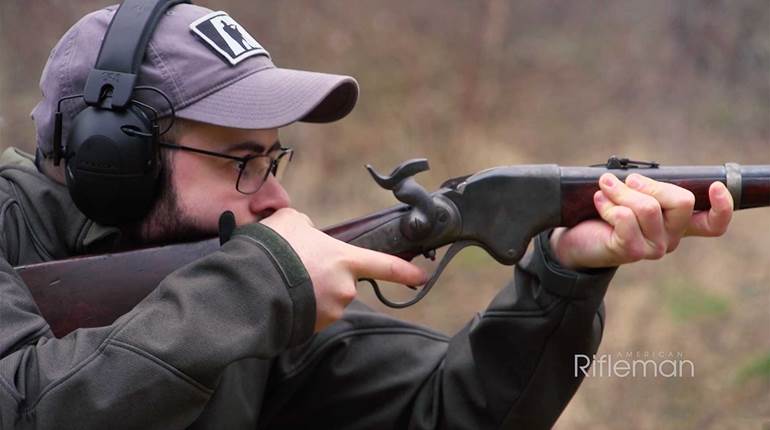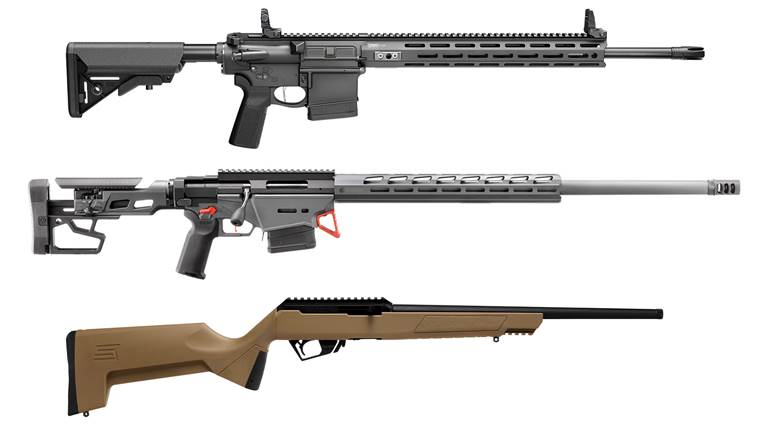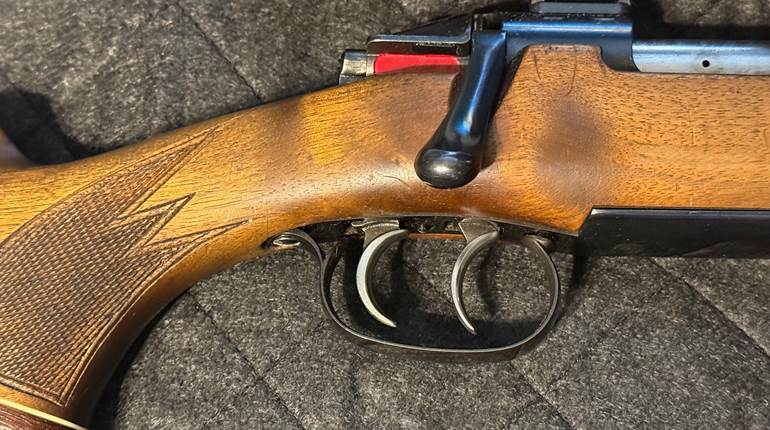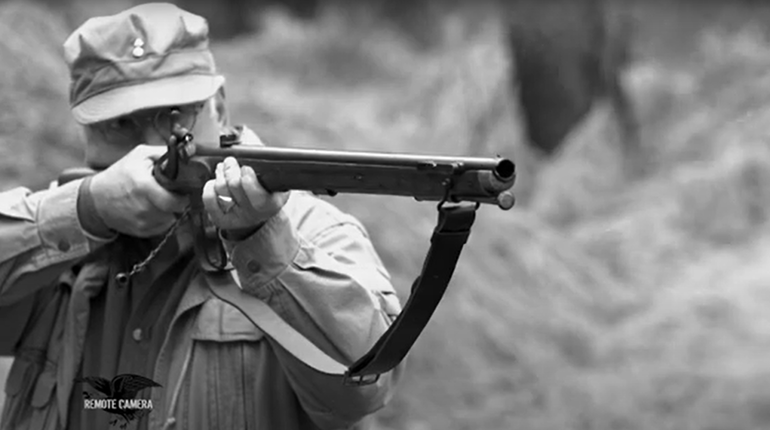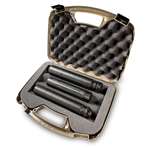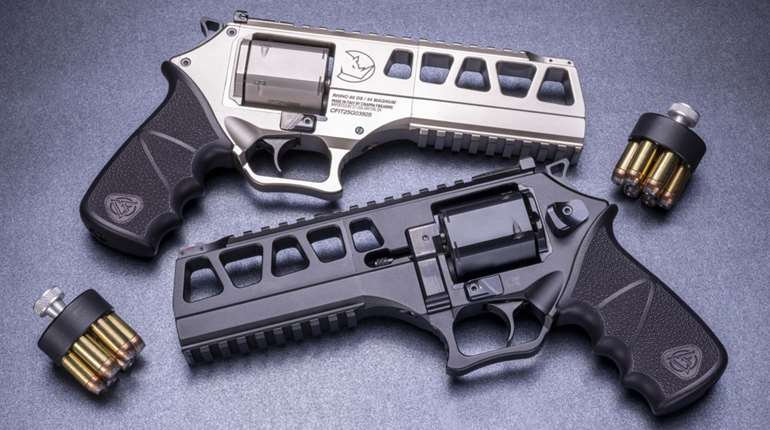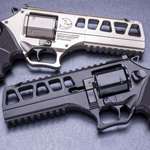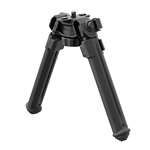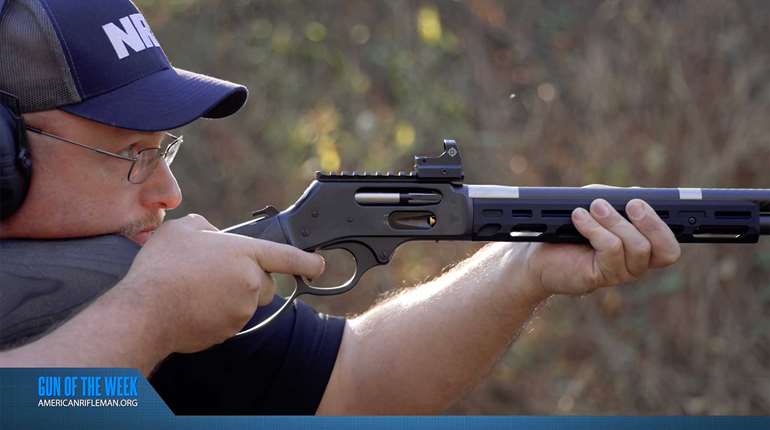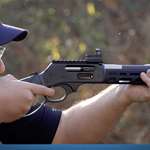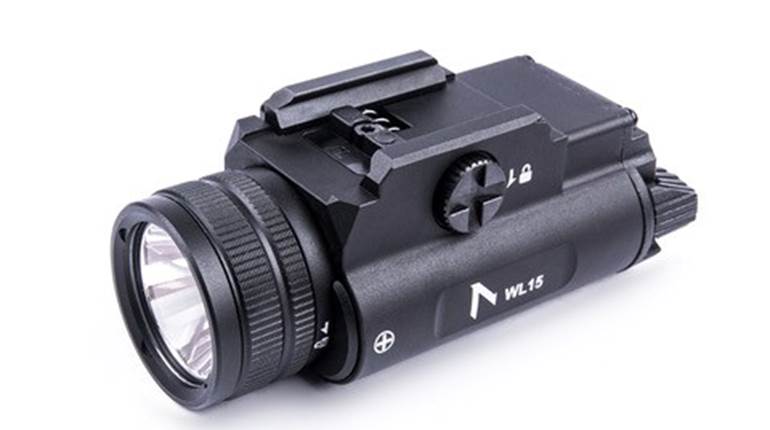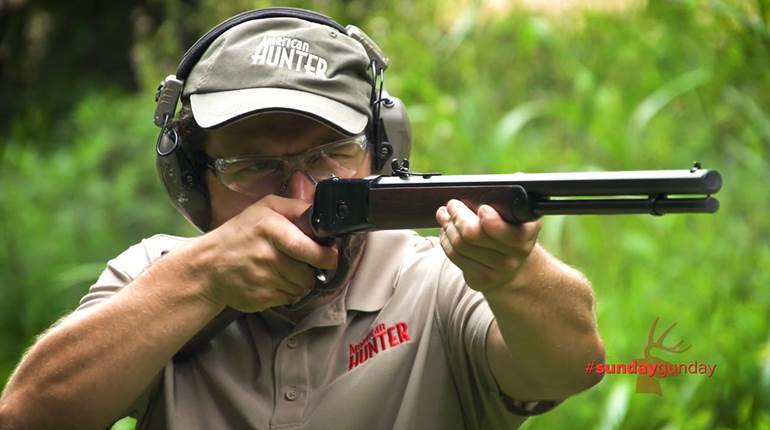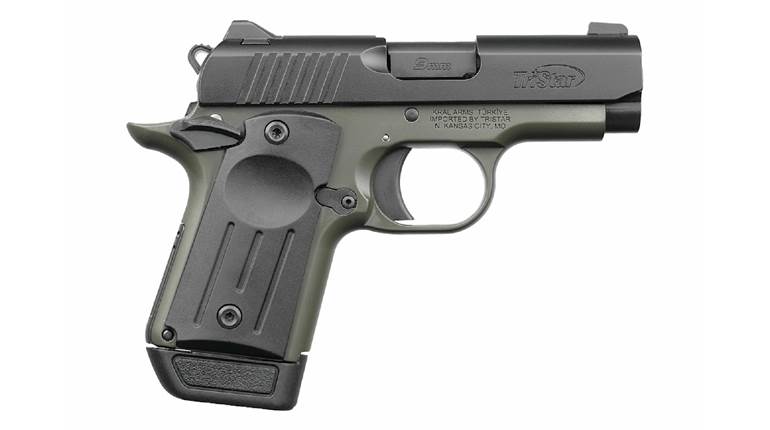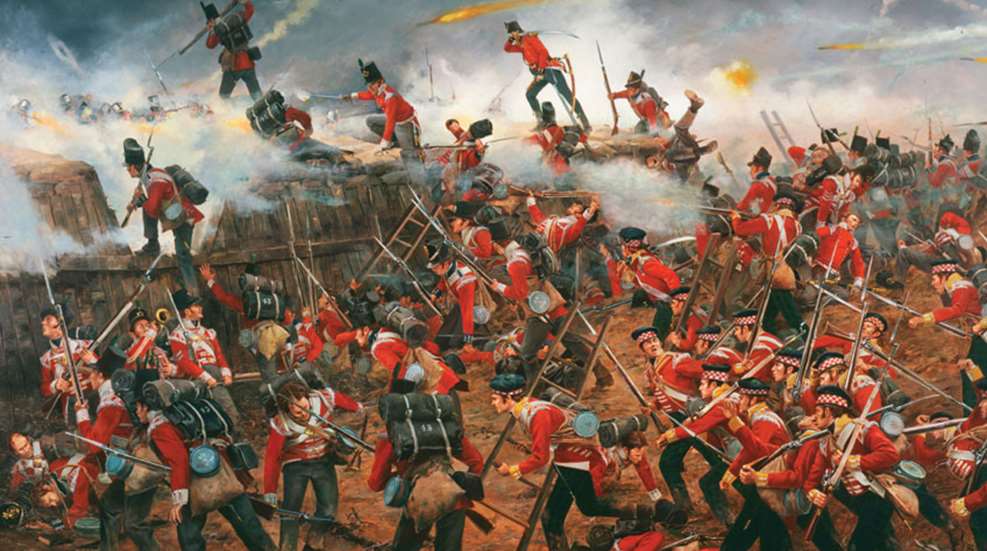
In "Battle of New Orleans — January 8th, 1815” by artist Don Troiani, light troops of the British 7th, 43rd and 93rd Regiments attack the Levee Redoubt on the American right. The battle, sadly, occurred after peace had been signed.
This year marks the bicentennial of the War of 1812—a conflict that, though largely ignored by the general public and academics, was a fascinating exercise of arms. The war marked an important early entry onto the world stage for the United States, established Britain’s Canadian territories as a definitive entity, and exacerbated the difficulties of Native Americans. The war also provided us with two of our most enduring national legends, the bombardment of Fort McHenry and the Battle of New Orleans.
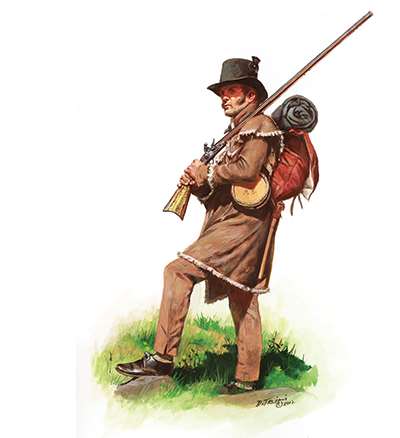
The fledgling American nation deserves credit for having the courage to take on the world’s superpower at the time, Great Britain. King George III had established a situation whereby any nation trading with France and other European countries had to first stop in England and pay a duty. Needless to say, this did not go over well with the neutral Yankees who depended a great deal on an unfettered economic relationship with Continental Europe.
Added to this was Britain’s high-handed practice of stopping American vessels on the high seas and forcibly taking seamen into the Royal Navy—never mind that the sailors might be naturalized U.S. citizens. It is estimated that some 6,000 men were so impressed into the King’s service.
In July 1812 the United States declared war on Great Britain, which was at war with France and little concerned with the young, upstart nation. Still a couple of stunning, unexpected American naval victories caused the British to take things more seriously, and the war began in earnest.
The United States at the time distrusted a large standing national army, so much of the fighting was done by militiamen and volunteers, and most of the men and leaders were woefully unprepared for the conflict. What they lacked in experience they thought they could make up in enthusiasm. Unfortunately that was not the case. On the British side there were regulars, Canadian militia and Native Americans whose preeminent leader, the Shawnee chieftain, Tecumseh, thought it would be in his people’s best interest to join the English, thus rekindling an alliance seen in two previous conflicts.
This wide variety of troops meant that there was also a broad selection of longarms fielded, including older, refurbished muskets, carbines and rifles and new, up-to-date-firelocks. As well, many civilian arms—blunderbusses to long rifles—were employed in some manner or another. Many Indians carried military muskets or trade guns, and sea service small arms were issued by both sides, but the latter are beyond the purview of this article. Here, we’ll take a look at a representative selection of the most widely used smoothbores and rifles employed in the conflict.
The Americans
Prior to 1794 Springfield Arsenal was a repository of firearms, rather than a manufacturer. The facility was storing thousands of French muskets, mostly Model 1763s and 1766s, left over from the Revolution. Some of those guns would ultimately find their way into the hands of Americans during the War of 1812, but it was decided by the authorities that as well as importing other foreign arms, including some from Britain, the United States needed an indigenous musket of its own.

Based on the military’s experience with, and confidence in, French muskets, it was deemed prudent to model the new musket after the French pattern arms. The official period designation was “U.S. Musket, Charleville pattern,” known today by collectors as the “Model 1795,” a term we will use hereon for the sake of convenience. The 1795 was a handsome piece, its overall look and construction leaving no doubt as to its Gallic inspiration. It had a flat lockplate with reinforced cock—flat or rounded depending upon when the gun was made—full-length walnut stock, three iron barrel bands (and iron furniture) and a 44 1/2-inch to 44 3/4-inch, .69-cal. smoothbore barrel. Its finish was bright. In 1800 another armory, Harper’s Ferry, also began producing Model 1795s.
Strangely enough, early “First Model” 1795s actually had their triangular bayonets brazed to their barrels, so they could not be removed. That odd practice was soon changed and the soldiers were issued separate 12- to 15 7/8-inch-bladed bayonets, which could be fitted over a stud at the muzzle and held in place by working the stud through an angular channel in the socket. A front sight blade was provided on the top of the front barrel band, though there was no rear sight notch.

As the output at Springfield in the early years was about 1,000 muskets per year, it was also thought wise to let out contracts to private gunmakers for 1795s, resulting in a large number of guns seen with contractor names on their lockplates. Those made at the national arsenals were dated on their locks and identified as to origin. There was also an eagle and “U.S.” Depending upon the date of manufacture, the styles of these markings would vary.
In fact, there were three distinct variations of the 1795 during its 20-year history of production, which have been broken down by modern collectors into specific model designations, a thing that was not done at the time.

Some states, such as Pennsylvania and Virginia, were not completely happy with the quantities of arms being turned out at Springfield and Harpers Ferry and made or contracted for arms of their own, most based on the French 1763 and U.S. Model 1795 patterns. Efforts by both the federal and state makers were eminently successful, and by the beginning of the war it is estimated that there were more than 200,000 muskets in U.S. armories.
Rifles also saw considerable use. Though by no means the most prevalent arm of its type in the war, the American longrifle has achieved the most notoriety because of its use by colorful volunteers, especially those from Kentucky.
The longrifle, which first appeared in the early part of the 18th century, evolved from shorter jaeger-style arms made by German and Swiss gunsmiths, many of whom settled in Pennsylvania. While styles varied considerably, most had, as their name implied, extended barrels often of 40 inches or more. They were usually of relatively small caliber as gunpowder and lead were expensive and this allowed the guns’ owners to take full advantage of what meager resources they had at their disposal. Decoration, involving wooden, brass, iron and sometimes silver patchboxes was common, as was carving and other inlays and embellishments.
The term “Kentucky Rifle,” while not in use at the time of the War of 1812, very probably was a result of the fray. During the famed Battle of New Orleans along with local civilians, pirates, state militia, and regulars, there were a number of Kentucky volunteers, many of whom were armed with longrifles.
In 1824 a popular song, “The Hunters of Kentucky,” appeared extolling the achievements of the Kentuckians at New Orleans, virtually inferring the frontiersmen won the battle single-handed. Actually the battle was decided more by artillery in fixed emplacements and rigid British tactics than by small arms, but no matter, the catchy tune caught on. With such verses as, “I s’pose you’ve read it in prints, how Packenham attempted/ To make old Hickory Jackson wince, but soon his schemes repented/ For we with rifles ready cocked, thought such occasion lucky/ And soon around the general flocked the hunters of Kentucky… . But Jackson he was wide awake, and wasn’t scared at trifles/ For well he knew what aim we take with our Kentucky rifles … .” The name, too, caught on, and since then has become the longrifle’s most common moniker.
Actually, the main American rifle during the War of 1812 was a federal project, the Model 1803. It was the first such gun manufactured by the U.S. Government.
Rather than following the style of the traditional longrifle, the 1803—considered by many to be one of the most beautiful American guns ever designed—was half-stocked and had a relatively short 33-inch half-round, half-octagon barrel. Caliber was .54 and furniture, to include a patchbox, was brass. Like the “Kentucky,” the Model 1803 could not be fitted with a bayonet, a tradition that carried on in the U.S. military for a good number of years. The Model 1803 was made solely at Harpers Ferry. Between 1803 and 1807 some 4,032 were manufactured, at which time production was stopped because of the light need for rifles and the limited numbers of rifle units extant.

Because the war increased the number of U.S. troops in the field, in 1814 a second batch of rifles, similar to the first but with 36-inch barrels, was authorized. Few probably saw service during the conflict. Production was kept up until 1820, by which time some 14,000 guns had been manufactured.
There were also other limited numbers of rifles turned out by different builders, with varying styles and embellishment, such as one I saw recently made at the Virginia Manufactory c. 1805 which had a wonderful patchbox in the shape of a coiled rattlesnake.
Federal, militia and volunteer rifle units took the field during the War of 1812, but because of the specialized nature and added cost of their arms, not to mention the extra time it took to train a rifleman versus that of a regular infantryman, they were seen in far fewer numbers than the men carrying smoothbores. As in the American Revolution, despite the oftentimes rugged terrain in which a battle would be fought, the older-style European tactics favoring smoothbore muskets were still maintained.
American mounted troops served in some numbers c. 1812-1815, but no specific carbine was specifically manufactured for their use. The same holds true for artillerymen who requested carbines, but none were forthcoming, and they generally had to rely on the longer muskets.
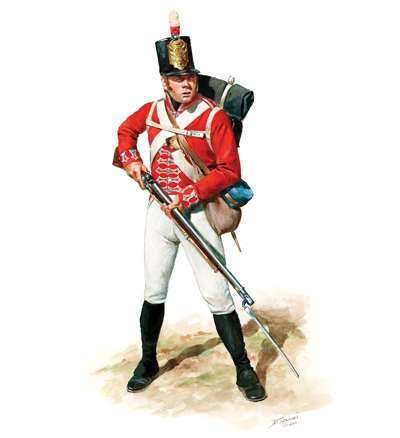
The British
While it is convenient to think the only troops fighting the Americans during the War of 1812 were British regulars, such was definitely not the case. Yankees had to contend with Indians, Canadian militia and Canadian volunteers along with Redcoats.
Like the Americans, many of the Canadians were using civilian arms as well as older French and British military muskets, the most common of which was the much-vaunted English Brown Bess.
Actually the term “Brown Bess” is a sobriquet for the regulation British flintlock smoothbore infantry musket that first appeared in the second quarter of the 18th century and continued as an issue arm for almost a century. Officially called the “King’s Arm” or “ Land Pattern musket” it went through an evolution, resulting in three basic patterns, the Long Land with a 46-inch barrel, Short Land with a 42-inch barrel and India Pattern with 39-inch barrel. Other features were also changed or altered, generally as manufacturing shortcuts or cost savings.

Where the term “Brown Bess” came from is lost to history though it appeared as early as 1785 and continued as a nom de guerre right up to the gun’s demise. By the time of the Napoleonic Wars the refined Short Land pattern was simply too time-consuming to manufacture, so the Board of Ordnance decided to equip the troops with the simple but robust India Pattern, so called because it had originally been designed as a gun for the troops of the British East India Company.
Unlike French pattern firelocks, which featured removable barrel bands, the Bess had its barrel pinned to a full-length walnut stock. Hardware, to include the buttplate, fore-end cap, sideplate and trigger guard were of brass. The robust lockplate featured a gooseneck cock, which was changed to a sturdier, reinforced style in 1809. The gun was finished in the bright, despite its nickname.
Besses were furnished with a triangular socket bayonet with a 17-inch blade. It was secured to the barrel by means of a stud on the top of the muzzle, which also served as a front sight, though like the Model 1785 there was no rear sight, aiming, such as it was, being most easily effected by lining up the stud with a midpoint at the breech.

While most of the Canadian militia and Crown forces already in North America probably carried a conglomeration of earlier model Besses, troops arriving in the United States during the war—including those that burned Washington—unquestionably carried Indias.
British rifle troops in the form of the 3rd Battalion, 95th Regiment of Foot, arrived on the scene late in the war after their service in Spain and Portugal. They had a presence in only a couple of engagements, the Battle of Villere Plantation and the Battle of New Orleans, but brought with them what was probably the finest military rifle of the period; what we now call the Baker Rifle.
At the time, this rugged, well-built arm was known officially as the “Infantry Rifle,” the later “Baker” appellation being given in tribute to gunmaker Ezekiel Baker who had considerable input into the gun’s design and adoption. With an overall length of 46 1/4 inches and a 30-inch, 0.625-cal. barrel of either twist or plain iron, the gun exuded serviceability. Furniture was of brass, including a butt box, which contained compartments for tools and greased patches. At the muzzle it was equipped with a notched bar to mount a brass-handled, 32-inch-bladed sword bayonet. In fact the British Rifles even today call their bayonets “swords” in tribute to this early edged weapon.
Baker’s sights included a blade front and folding leaf rear, which was set to 100 and 200 yards. The full-length walnut stock incorporated a generous cheekpiece. Locks were of carbine size and, depending upon the model, cocks could either be goosenecked or reinforced. Like the Brown Bess’ lockplate markings included the sovereign’s monogram (“GR” for “Georgius Rex”—King George III), “TOWER” and the date. Barrels were browned and other parts, to include the false breech and lock, case-hardened—altogether an extremely handsome arm, that was highly esteemed by the men who used it.

The earlier years of the war did not go well for the Americans, but as troops became more seasoned and younger, more progressive officers emerged, things began to turn around. By the time both sides had decided they were finished, Britain, at first thinking she would have the upper hand in peace negotiations, came to realize that such was not the case and had to settle for what ultimately turned out to be a draw.
Interestingly enough, because of the time it took to get information to America from Europe, the most famous land engagement, the Battle of New Orleans, was actually fought after the ratification of the treaty of Ghent in 1815. For Americans, though, the news of this lopsided battle (approximately 300 Americans killed, wounded and missing versus some 2,500 British, including the death of British commander Gen. Edward Pakenham) came prior to the notification of the treaty, and they associated Andrew Jackson’s stunning victory with the favorable terms of peace and it has been extolled as a great feat of American arms ever since.
While not one of America’s best remembered conflicts, The War of 1812 solidified the United States’ presence in the family of nations. Experiences with the heavy reliance on militia also proved to the Yankees, that despite earlier misgivings, it was important to maintain a reasonable permanent national army, and from that point on—though there would be ups and downs—the federal government would begin to take preeminence in things military.
Shooting The Guns of 1812
Muskets
During the flintlock era, the average soldier was expected to be able to load and fire his smoothbore musket at least three or four times per minute. To achieve that rate men were drilled in a number of formalized movements.
Trimmed to the basics, they involved the soldier removing a paper cartridge, containing powder and ball, from his cartridge box, biting off the end, priming the flashpan and then pouring the remaining powder down the barrel followed by the paper-wrapped bullet which was rammed down on top of the charge.
The gun was then brought to full cock, aimed and fired. Accuracy with a smoothbore was not great. At 50 yds. one could expect to strike what he was aiming at with reasonable surety, but after that the probability of hits dropped off drastically. Given the massed formation tactics of the period, it is easy to see why speed of loading was of paramount importance.
Rifles
The rifle was more of a specialist’s arm than the common musket. It took longer to train a man to shoot a rifle properly, the guns were more expensive to make and took about three times longer to load than a smoothbore.
Basically the solider had to load his bullet using a tight-fitting patch to grip the rifling. Priming and powder for the main charge were normally supplied from horns or flasks and patches were either applied separately (particularly with the long rifle) or were issued sewn around the round ball.
Accuracy with rifles was far superior to that of the musket with 300-yd. hits not being uncommon. British rifleman Tom Plunkett wrote of his experience with the Baker Rifle in the Napoleonic Wars, “… 200 yards was the greatest range I could fire with certainty. I have shot very well at over 300 when the wind was very calm. At 400 and 500 I have sometimes struck the object, though I have found it to vary much.”
9/27/2012 "Longarms Of America's Forgotten War"












